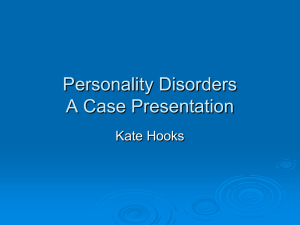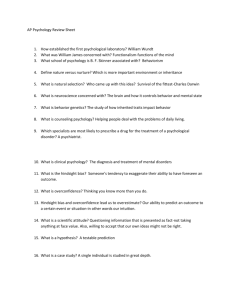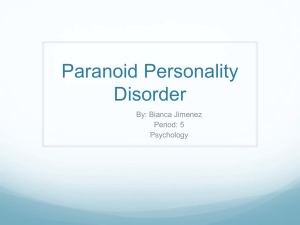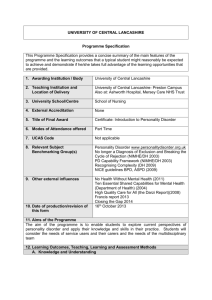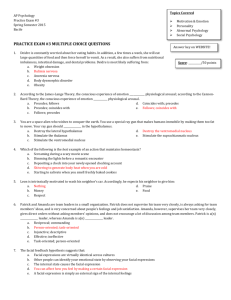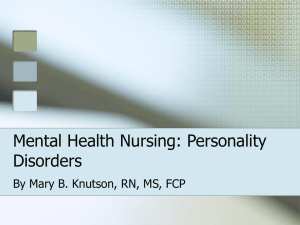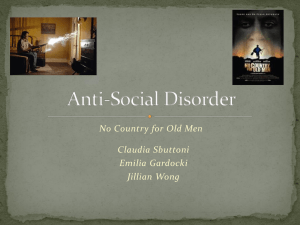Antisocial Personality Disorder
advertisement
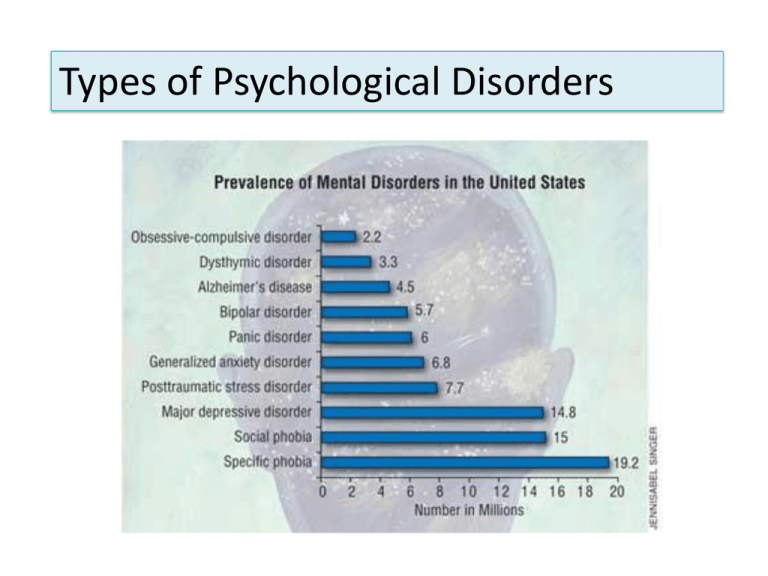
Types of Psychological Disorders Obsessions Compulsions • Recurrent thoughts, impulses and images • Repeated, irresistible behaviors that often follow the experience of obsessions Behavioral View: • The compulsions act to reduce the anxiety • experienced as a consequence of the obsessions and are thus reinforcing. Biological (Medical) View: • Genetic component • The frontal lobe (responsible for thinking and • planning), and the basal ganglia (responsible partly for motor movement) are affected in OCD patients. Brains of OCD patients What is Dissociative Identity Disorder? , Often occurs in people who were sexually A condition in which an individual develops two or more distinct identities. Dissociative Identity Disorder Previously known as Multiple Personality Disorder Extremely Rare abused as children. When faced with extreme abuse, they disconnect from selves and become someone else for preservation The famous patient “Sybil” was really Shirley Mason and the film is a fictionalized account. Severe Personality Disorders Paranoid Personality Disorder Schizoid Personality Disorder • Suspicious • self-destructive but not psychotic; difficult to • get along with; always questioning, always • examining every single detail • psychotic; high degree of aloofness, distance • secretiveness; not lonely but loners. Borderline Personality Disorder • Instability in one’s self-image, mood, and social relationships • lack of clear identity. • Very codependent Antisocial Personality Disorder: • Chronic • pattern of selfcentered, manipulative, • destructive behavior toward others; lack of remorse; zero chance of recovery. • One-fourth • are women– most men What is the difference between a sociopath and a psychopath? It depends who you ask. The terms "sociopath" and "psychopath" describe pretty much the same personality disorder—people who feel no emotional connections to others and have zero regard for the rules and regulations of society. When most people think of a "psychopath," they think of a serial killer. Although some people with this disorder are killers, the vast majority are not. Today they are referred to as “Antisocial Personality Disorder” Signs of A.S.P.D. • Impulsivity or failure to plan ahead • Irritability and aggressiveness, as indicted by repeated physical fights or assaults • Reckless disregard for safety of self or others • Consistent irresponsibility, as indicated by repeated failure to sustain consistent work behavior or honor financial obligations • Lack of remorse, as indicated by being indifferent about having hurt, mistreated or stolen from another • Lying or stories don’t add up • Will slowly and subtly separate you from people who may question his plans. He may intercept phone calls from your friends. He may refuse to associate with your family. • Sociopathic con artists often exhibit a "predatory stare"— unblinking, fixated and emotionless. It's not a sign of empathy—it's an effort to assert control. • Extreme and sudden “love” when they hardly know you. Lavish flattery 14 Signs of a potential serial killer Over 90 percent of serial killers are male They tend to be intelligent, with IQ's in the "bright normal" range They do poorly in school, have trouble holding down jobs, and often work as unskilled laborers. They tend to come from markedly unstable families. As children, they are abandoned by their fathers and raised by domineering mothers. Their families often have criminal, psychiatric and alcoholic histories. They hate their fathers and mothers. They are commonly abused as children: psychologically, physically and sexually. Often the abuse is by a family member. Many serial killers spend time in institutions as children and have records of early psychiatric problems. They have high rates of suicide attempts. From an early age, many are intensely interested in voyeurism, fetishism, and sado-masochistic pornography. More than 60 percent of serial killers wet their beds beyond the age of 12. Many serial killers are fascinated with fire starting. They are involved with sadistic activity or tormenting small creatures Source: Internal Association of Forensic Science, an article written by FBI Special Agent Robert K. Ressler "The Serial Killer," Harold Schechter

